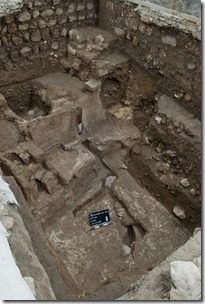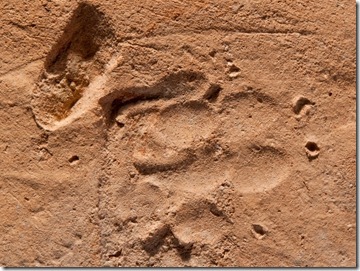The Israel Antiquities Authority announced today the discovery of a second-century Roman bathhouse in the Jewish Quarter of Jerusalem. The excavation was being conducted in advance of construction of a ritual bath (miqve). According to archaeologist Ofer Sion:
It seems that the bathhouse was used by these soldiers who were garrisoned there after suppressing the Bar Kokhba uprising in 135 CE, when the pagan city Aelia Capitolina was established. We know that the Tenth Legion’s camp was situated within the limits of what is today the Old City, probably in the region of the Armenian Quarter. This assumption is reinforced by the discovery of the bathhouse in the nearby Jewish Quarter which shows that the multitude of soldiers was spread out and that they were also active outside the camp, in other parts of the Old City.
The discovery of a paw print on one of the roof tiles created some excitement:
Another interesting discovery that caused excitement during the excavation is the paw print of a dog that probably belonged to one of the soldiers. The paw print was impressed on the symbol of the legion on one of the roof tiles and it could have happened accidentally or have been intended as a joke.
Yuval Baruch, Jerusalem district archaeologist, explains the larger significance:
What we have here is a discovery that is important for the study of Jerusalem. Despite the very extensive archaeological excavations that were carried out in the Jewish Quarter, so far not even one building has been discovered there that belonged to the Roman legion. The absence of such a find led to the conclusion that Aelia Capitolina, the Roman city which was established after the destruction of Jerusalem, was small and limited in area. The new find, together with other discoveries of recent years, shows that the city was considerably larger than what we previously estimated. Information about Aelia Capitolina is extremely valuable and can contribute greatly to research on Jerusalem because it was that city that determined the character and general appearance of ancient Jerusalem and as we know it today. The shape of the city has determined the outline of its walls and the location of the gates to this very day.
The press release and three high-resolution photos (including the two photos above) are available at the Israel Antiquities Authority site (temporary link). The story is also reported by the Jerusalem Post, Arutz-7, and CNN.
UPDATE (11/23): The Jerusalem Post now features a 2.5 minute video of the discovery. Several new photos are posted at CBS News.


3 thoughts on “Roman Bathhouse Discovered in Jerusalem’s Jewish Quarter”
Any idea exactly where this is?
Leen Ritmeyer's blog has a map.
http://blog.ritmeyer.com/
Carl
The direct link to Ritmeyer's post is:
http://www.ritmeyer.com/2010/11/22/roman-bathing-pool-found-in-jerusalem/